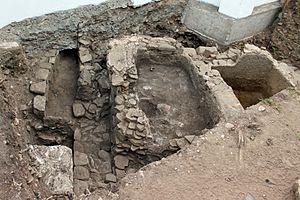Roman fish salting factory facts for kids
The Roman fish salting factory (Spanish: Factoría romana de salazones) was a special place in Algeciras, southeastern Spain. The Romans built it right by the sea a long, long time ago! It was a factory where they prepared fish by salting it. This helped them keep the fish fresh for a long time. This old factory is very important for history and archaeology. Because of its importance, it was officially named a Bien de Interés Cultural (which means a "Site of Cultural Interest") on June 27, 2002.
Contents
What Was a Roman Fish Salting Factory?
A Roman fish salting factory was a place where people processed fish to preserve it. In ancient times, there were no refrigerators! So, to stop fish from spoiling, Romans used salt. They would clean the fish, cut it up, and then layer it with lots of salt in large tanks. This process took out the water and stopped bacteria from growing.
Why Was Salting Fish Important?
Salting fish made it possible to store food for a long time. This was super important for feeding Roman cities and armies. Salted fish could be transported far away without going bad. It was a major part of the Roman diet and trade.
Where Was This Factory Located?
The factory was built right on the coast of what is now Algeciras. This area was once part of a Roman fishing village called San Nicolás. This village was also known as Caetaria. Being close to the sea was perfect for getting fresh fish directly from the boats.
How Did They Build It?
Archaeologists have found the remains of many large tanks at the site. These tanks were made of stone and covered with a special waterproof plaster. This plaster stopped the salty water from leaking out. Workers would put fish and salt into these tanks.
What Did They Make There?
Besides salted fish, these factories often produced a famous Roman sauce called garum. Garum was a very popular condiment, like ketchup or soy sauce today. It was made from fermented fish guts and blood, mixed with salt. It had a strong, savory flavor and was used in many Roman dishes.
Garum: A Special Roman Sauce
Garum was a valuable product and was traded all over the Roman Empire. It was made by letting fish parts sit in salt under the sun for weeks or months. This process created a rich, salty liquid. It might sound a bit strange to us today, but it was a delicacy for the Romans!
Why Is This Factory Important Today?
The Roman fish salting factory in Algeciras is a very important archaeological site. It helps us learn about how Romans lived, what they ate, and how they traded goods. When archaeologists dig here, they find clues about daily life thousands of years ago.
What Does "Bien de Interés Cultural" Mean?
Being declared a "Bien de Interés Cultural" means that the site is officially recognized as a very important part of Spain's heritage. This special status helps protect the factory remains. It ensures that this historical treasure will be preserved for future generations to study and enjoy.
See also
 In Spanish: Factoría romana de salazones (Algeciras) para niños
In Spanish: Factoría romana de salazones (Algeciras) para niños


